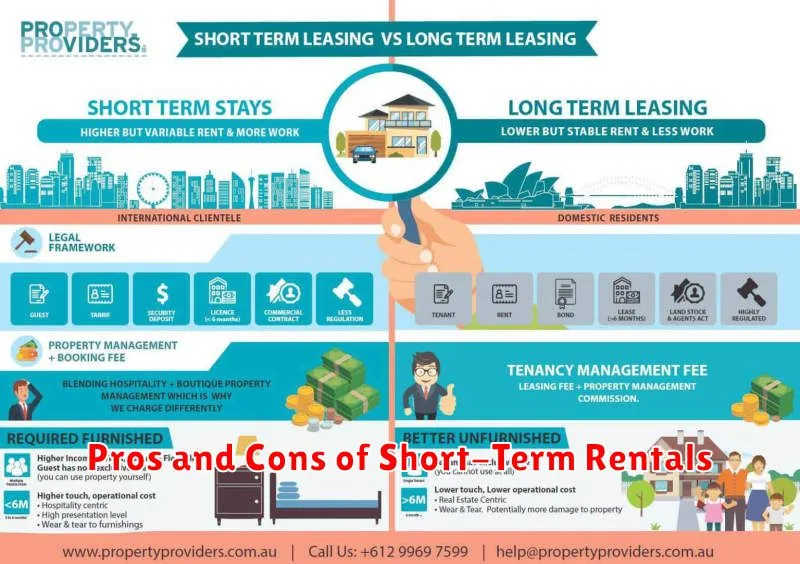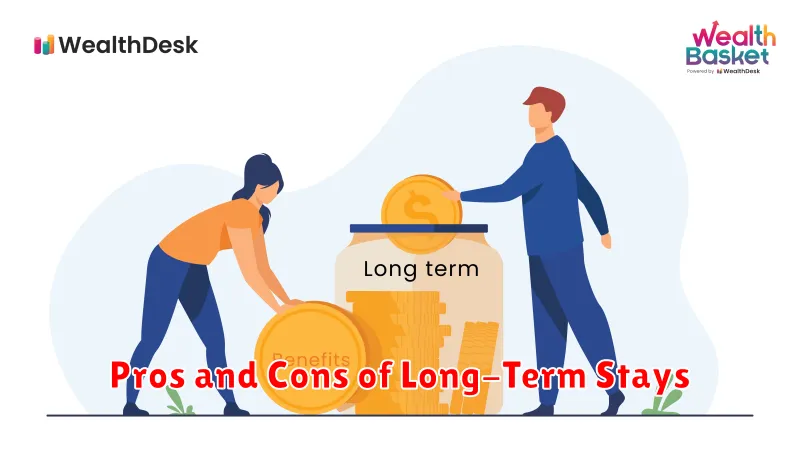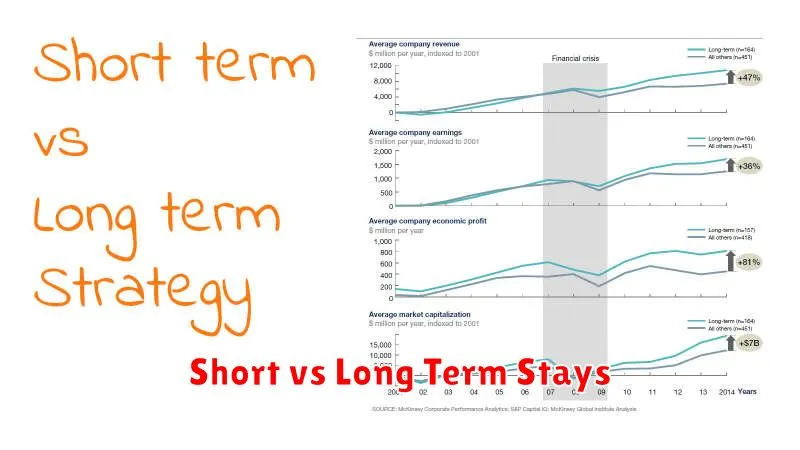Are you planning a trip and struggling to decide between a short-term rental or a long-term stay? This decision can significantly impact your budget, comfort, and overall travel experience. Finding the perfect accommodation hinges on understanding your needs and priorities. This article will break down the pros and cons of both short-term rentals (like Airbnb or VRBO) and long-term stays (like apartments or extended-stay hotels), helping you choose the best option for your upcoming adventure. Let’s dive in and discover which type of accommodation offers the ultimate value and convenience for you!
Introduction: Understanding Short-Term and Long-Term Rentals
Choosing between a short-term rental and a long-term rental depends heavily on your individual needs and circumstances. Understanding the key differences is crucial for making the right decision.
Short-term rentals, typically lasting a few days to a few months, offer flexibility and are ideal for vacations, business trips, or temporary relocation. They often come furnished and include amenities, making them convenient for short stays. However, they usually come with higher costs per night or week.
Long-term rentals, on the other hand, involve leases lasting several months or even years. They provide stability and are often more cost-effective in the long run. While they may require a security deposit and may not always come furnished, they offer greater predictability and a sense of permanence.
This article will delve deeper into the pros and cons of each type of rental, helping you determine which option best suits your lifestyle and budget.
Pros and Cons of Short-Term Rentals

Short-term rentals, like those offered through Airbnb or VRBO, offer a unique travel experience with several advantages. Flexibility is a major pro; you can book stays for a few days or weeks, adapting to your schedule. This also allows for spontaneity, letting you change your plans easily. Furthermore, short-term rentals often provide more space and amenities than a typical hotel room, such as a kitchen, laundry facilities, and sometimes even a backyard – perfect for families or groups.
However, short-term rentals also present drawbacks. Consistency can be an issue; the quality and cleanliness can vary significantly between properties. Cost can sometimes be higher than a long-term stay, especially for extended periods, though this isn’t always the case. Lack of services typically found in hotels (like daily housekeeping) is another consideration. Finally, there’s a potential for unexpected issues; dealing with maintenance or communication problems with the host might require more effort than with a hotel.
Pros and Cons of Long-Term Stays

Choosing between a short-term rental and a long-term stay is a significant decision. Let’s examine the advantages and disadvantages of opting for a longer-term arrangement.
Pros of Long-Term Stays: Cost savings are often a major draw. Monthly rates tend to be lower than daily or weekly rates for short-term rentals, especially when considering extended stays. You also benefit from stability and consistency; knowing where you’ll be living for an extended period can reduce stress and improve your quality of life. Furthermore, long-term rentals often come with amenities such as included utilities, appliances, and potentially even furniture, simplifying your move and reducing ongoing expenses. A sense of community can also develop, fostering stronger connections with neighbors and the surrounding area.
Cons of Long-Term Stays: Less flexibility is a key drawback. Breaking a long-term lease can be costly and complicated, limiting your options if your circumstances change. Finding the right property can be more time-consuming, requiring thorough research and potentially compromising on certain preferences to secure a lease. Compared to short-term rentals, decor and personalization options might be limited, as you may not be able to make significant changes to the property without landlord permission. Furthermore, resolving maintenance issues might require more patience and coordination with property managers, unlike the quick response times often available in short-term rentals.
Key Factors to Consider When Choosing Rental Options
Choosing between a short-term rental and a long-term lease depends heavily on your individual needs and circumstances. Several key factors should guide your decision.
Budget: Short-term rentals often have higher nightly or weekly rates than long-term leases, resulting in higher overall costs for extended stays. However, long-term leases involve upfront costs like security deposits and potentially higher initial move-in fees. Carefully compare the total cost of each option over your desired timeframe.
Length of Stay: This is perhaps the most obvious factor. Short-term rentals are ideal for temporary stays—vacations, business trips, or temporary relocations—while long-term leases are better suited for stays of several months or more. Consider the flexibility each option offers regarding your planned duration.
Flexibility and Amenities: Short-term rentals often offer greater flexibility, allowing you to easily adjust your stay length. They may also come with more amenities, such as fully equipped kitchens and laundry facilities. Long-term leases typically offer more stability and, sometimes, included amenities like utilities. Assess your needs for flexibility and convenience.
Location and Lifestyle: Consider your preferred location and the lifestyle associated with each option. Short-term rentals often offer a wider variety of locations and potentially more luxurious accommodations, though this often comes at a price. Long-term leases might offer a more established and community-integrated experience.
Lease Terms and Conditions: Thoroughly review the lease agreements for both options. Pay close attention to cancellation policies, payment schedules, and any restrictions on guests or activities. Understanding the terms will help you make an informed decision.
How Costs Vary Between Short-Term and Long-Term Stays
The biggest difference between short-term and long-term rentals lies in the cost. Short-term rentals, like those booked through Airbnb or VRBO, typically have higher nightly rates than long-term rentals. You’ll often pay a premium for the convenience and flexibility of shorter stays.
Long-term rentals, on the other hand, offer lower monthly rates. While the initial cost might seem higher than a few nights in a short-term rental, the overall cost per night significantly decreases the longer you stay. This makes long-term rentals much more economical for extended periods.
Beyond the base rent, consider additional costs. Short-term rentals often include cleaning fees, service fees, and potentially higher utility costs (depending on usage and billing practices). Long-term rentals usually have a fixed monthly utility allowance, potentially leading to predictable expenses. However, you’ll typically be responsible for utilities exceeding the allowance in long-term leases.
Finally, security deposits are another factor. Short-term rentals often require a smaller security deposit than long-term rentals, but the higher nightly rate might offset this difference. Remember to carefully review all fees and charges before committing to either a short-term or long-term stay to accurately compare the total cost.
Tips for Managing Rental Agreements
Regardless of whether you choose a short-term or long-term rental, meticulous agreement management is crucial. Start by using a clearly written, legally sound contract that covers all essential aspects, including rent, utilities, responsibilities, and termination clauses.
For short-term rentals, consider using a standardized template and ensure the agreement details the booking process, cancellation policies, and guest responsibilities. Detailed check-in/check-out procedures are vital to minimize disputes.
Long-term rental agreements benefit from more comprehensive clauses addressing issues like lease renewals, pet policies, and repair responsibilities. Regularly review the agreement with your tenant and maintain open communication to address concerns proactively.
In both cases, always obtain a security deposit and clearly outline its purpose and how it will be handled. Consider using a third-party escrow service for added security and transparency. Finally, keep meticulous records of all communications, payments, and maintenance requests.
By focusing on clear communication and thorough documentation, you can significantly reduce the potential for conflicts and ensure a smooth rental experience, whether it’s short-term or long-term.
Who Benefits More from Short-Term Housing?
Short-term housing, like vacation rentals or extended-stay hotels, offers several advantages over long-term leases. Individuals who benefit most are those with flexible timelines, such as travelers, relocating professionals needing temporary housing, or individuals undergoing renovations.
Business travelers frequently utilize short-term rentals for convenience and cost-effectiveness, avoiding the commitment of a long-term lease. Similarly, those relocating to a new city might use short-term rentals to explore different neighborhoods before committing to a long-term residence. Patients seeking treatment in a new location also benefit from the temporary housing provided.
Ultimately, the ideal choice depends on individual circumstances. While long-term leases offer stability and potential cost savings in the long run, short-term rentals prioritize flexibility and convenience for those with temporary needs. Weigh your specific situation carefully to determine which option best suits your requirements.
The Flexibility of Long-Term Rentals for Families
Long-term rentals offer families a unique level of flexibility not found in short-term options. The extended lease period allows for greater stability and the ability to truly make a house a home.
This stability translates to numerous benefits for families. Children can settle into a consistent routine, building stronger bonds with their neighborhood and school community. Parents gain the freedom to personalize the space, creating a truly comfortable and functional environment that caters to their family’s specific needs. This may include adding child-safe features, decorating to create a welcoming atmosphere, or even making minor renovations that wouldn’t be feasible in a short-term rental.
Furthermore, the extended timeframe allows for greater cost-effectiveness. While the initial upfront cost might seem higher, long-term rentals often come with lower monthly rates compared to the accumulated cost of multiple short-term bookings. This predictable monthly expense aids in budget planning, crucial for families managing household finances.
Flexibility also extends beyond the financial aspect. Long-term rentals often allow for more negotiation with landlords regarding pet policies, lease terms, and even minor renovations, creating a more personalized and accommodating living arrangement tailored to the family’s unique lifestyle.
In essence, while short-term rentals offer immediate convenience, long-term rentals provide a foundation of stability and flexibility that is uniquely valuable for families, allowing them to create a true home and fostering a sense of belonging and security.
Conclusion: Choosing the Right Option Based on Your Needs
Ultimately, the best choice between a short-term rental and a long-term stay depends entirely on your individual needs and circumstances. Consider the length of your trip, your budget, and your desired level of comfort and amenities.
Short-term rentals offer flexibility and a taste of local living, ideal for vacations or short business trips. They often come furnished and equipped, minimizing the need for personal belongings. However, they can be more expensive per night and lack the stability of a long-term arrangement.
Long-term stays provide cost savings over time and a sense of settling in, perfect for extended vacations, relocations, or sabbaticals. They offer more space and often include amenities like laundry facilities. The trade-off is a longer-term commitment and less flexibility.
Carefully weigh the pros and cons of each option to determine which best aligns with your travel style, financial considerations, and overall priorities. By doing so, you can make an informed decision that ensures a comfortable and enjoyable stay.

